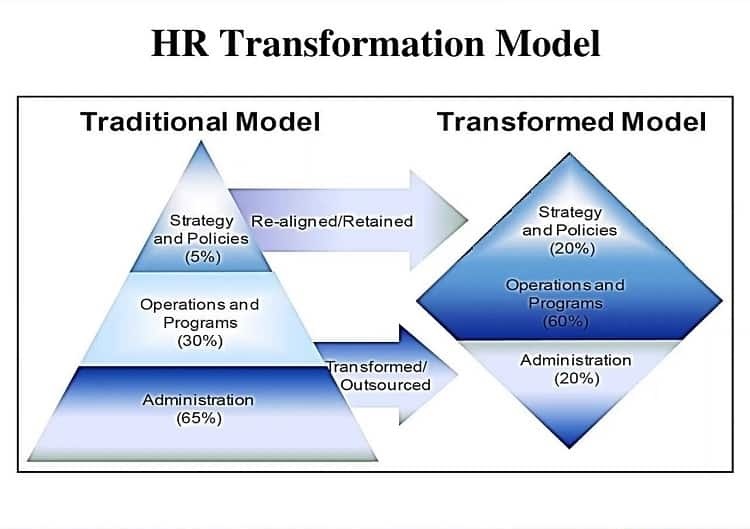Discover how to do HR Transformation and secure a competitive spot for your organization among the current dynamic labor market!
In the dynamic landscape of today’s business world, HR Transformation stands out as a focal point within the realm of human resources. As the labor market undergoes continuous shifts – characterized by increasing competition for talent and evolving workplace dynamics – the need for a robust talent management strategy has become paramount for organizational sustainability.
More than ever, businesses are turning to their HR departments to formulate and execute effective strategies. This shift signifies a significant evolution in the role of HR, transcending its traditional functions to become a strategic partner in driving business success. In other words, organizations are placing greater expectations on HR to deliver tangible value and contribute directly to visualizing business objectives.
(by Jonathan M. Pham)
Highlights
- A holistic restructuring of HR functions to align with organizational strategy, HR transformation evolves from a focus on cost reduction to prioritizing employee engagement, talent development, and organizational growth. It is crucial for adapting to changing demographics, rapid business model evolution, and the need for transparent technology to drive organizational success and revenue generation.
- HR transformation involves a strategic shift from a siloed, vertical function to a horizontal, integrated business partner role, where people and skills considerations are central to all key business decisions and aligned with overarching business goals. The aim is to enhance organizational agility, employee experience, and data-driven decision-making by streamlining processes, improving data security, ensuring compliance, responding to talent needs, and promoting collaboration.
- As a popular approach to HR transformation, Dave Ulrich’s model emphasizes minimizing administrative tasks through automation, cultivating HR as a change agent, focusing on outcomes over activities, and involving all organizational levels in a comprehensive transformation encompassing structure, processes, and culture to meet evolving employee expectations.
- Successful HR transformation requires prioritizing the human element, securing leadership buy-in, leveraging technology, developing a comprehensive plan, and harnessing data.
What is HR Transformation?
HR Transformation refers to a holistic restructuring of the human resources department’s function, with the aim of realigning its core objectives with the organization’s strategic imperatives. It involves a fundamental reevaluation and redesign of HR practices to ensure they effectively support and propel the overarching business goals.
In its earlier iterations during the 1990s and early 2000s, HR transformation primarily centered on optimizing performance and cost reduction initiatives. However, these days, the focus has shifted towards augmenting the workforce’s contribution to organizational objectives. This evolution underscores a strategic shift wherein HR is no longer solely concerned with administrative functions – but rather, with enhancing employee engagement, fostering talent development, and driving organizational growth.

Why HR Transformation?
The aftermath of the Covid-19 pandemic has presented Chief Human Resource Officers (CHROs) with unprecedented challenges. This crisis has underscored the critical role of human capital in securing competitive advantage, fostering customer & employee loyalty, and advancing long-term organizational goals.
Amidst adversity, opportunities still await. The current scenario accentuates the imperative for accelerating HR transformation efforts, enabling businesses to:
- Embrace reality: The strategic importance of people-centric strategies for the organization’s future.
- Enhance problem-solving capabilities: Agile adaptation to seize emerging opportunities and cultivate an enriching work environment that drives business value.
Traditionally, HR functions have placed a strong emphasis on vertical depth. However, to facilitate organizational adaptation and transformation, HR must evolve horizontally, by forging genuine partnerships with other stakeholders and sharing accountability for outcomes. HR Transformation signals an inevitable shift wherein the HR department assumes a pivotal role in driving revenue generation and sales expansion.

Below are 3 key drivers that necessitate the expedition of the HR transformation process:
- Changing demographics: Today’s workforce is characterized by diverse generational cohorts, ranging from millennials to seasoned professionals. In response, HR must devise flexible policies, support knowledge transfer initiatives, and facilitate retraining efforts to accommodate varying needs.
- Rapid business model evolution: In an ever-changing business landscape, seamless collaboration among team members has become indispensable. As such, managers must adeptly form and reshape teams to meet evolving demands. Neglecting the development of talented employees risks inefficiency and attrition.
- Transparent technology: Modern expectations demand user-friendly, efficient systems. In other words, outdated HR management platforms will just deter employee engagement and hinder organizational progress. Investing in advanced technology is a must – so as to enhance operational efficacy, and foster employee trust and participation.
Read more: Future Ready Organization – 11 Tips to Building One
HR Transformation: A Strategic Shift in the Department’s Function
The future of HR is horizontal, working as an integrated enabler, ensuring that all key decisions are made with people and skills considerations top-of-mind across the business, rather than operating as a standalone vertical.
Danny Ferron
In the evolving landscape of organizational dynamics, the future trajectory of Human Resources (HR) entails a horizontal development, transcending its traditional siloed function to emerge as an integrated executive agency. This strategic metamorphosis underscores the imperative for all pivotal decisions to be grounded in an understanding of the organization’s people and capabilities, thereby fostering a seamless alignment between HR initiatives and overarching business goals.
True HR transformation manifests when the HR department assumes the mantle of a strategic business partner (HRBP), ensuring that all people-related strategies are intricately intertwined with the overarching business imperatives. This symbiotic engenders a harmonious convergence of organizational objectives and HR initiatives.
For HR to deliver maximum impact, it needs to be integrated with business, and business needs to be integrated with HR.
Jeremie Brecheisen, Gallup’s senior consultant
Central to achieving this integration is a concerted effort by organizational leaders to dismantle conventional barriers and foster a culture of collaboration. As highlighted in research by McKinsey, leaders need to ‘blur the lines’ between themselves and departmental heads, fostering a network of interdependent relationships founded on shared values and mutual exchange of information.
At this pinnacle of transformation, the HR department assumes a strategic consulting role, offering insights into pivotal business decisions. Examples of the value proposition that HR can bring to the table include:
- Advising on industry trends such as talent poaching amidst stock fluctuations
- Assessing the organization’s readiness to pivot into new sectors, and
- Providing guidance on workforce organization and automation integration.
However, reaching this zenith necessitates meticulous planning by HR leaders and senior management. Crafting a comprehensive HR transformation strategy demands a nuanced understanding of the intricate interplay between organizational dynamics, technological advancements, and workforce capabilities. Only through meticulous planning and strategic foresight can organizations unlock the full potential of HR transformation and propel themselves towards sustained success.
Read more: Unveiling the HRBP Model – Revolutionizing Human Resources Management

Objectives of HR Transformation
The goals of HR transformation are multifaceted and encompass a spectrum of strategic imperatives – with the aim of fostering organizational agility, enhancing employee experiences, and driving data-informed decision-making. These objectives include:
- Delivering consumer-level employment experiences: Elevating the employee experience to mirror consumer-grade standards, thereby fostering engagement, satisfaction, and retention.
- Minimizing manual, administrative work for HR, managers, and employees: Streamlining HR processes to alleviate administrative burdens and enhance operational efficiency.
- Supporting business leaders to make timely, data-driven decisions: Equipping business leaders with actionable insights derived from robust data analytics, facilitating informed decision-making and strategic planning.
- Improving the security of human resources information: Implementing data security measures to safeguard sensitive HR information and ensure regulatory compliance.
- Complying with ever-changing legal and regulatory requirements: Staying abreast of evolving legal and regulatory landscapes to ensure compliance and mitigate legal risks.
- Responding quickly to organizational talent requirements: Anticipating and addressing talent needs swiftly to align with organizational objectives and market demands.
- Promoting collaboration and productivity within the organization and HR department: Fostering a culture of collaboration and productivity by leveraging innovative HR technologies and cultivating cross-functional partnerships.
To achieve these objectives, HR departments must embrace a holistic approach, by leveraging new HR technologies, standardizing processes based on internal and industry best practices, identifying key career milestones tailored to employee needs, restructuring the HR function, and enhancing the management, analytical, and consulting skills of HR staff.
By aligning HR initiatives with organizational goals and investing in continuous improvement, businesses may drive meaningful transformation and achieve sustainable growth.
HR Transformation Roadmap

HR Transformation roadmap – Maturity framework
Source: oracle.com
To embark on the journey of HR transformation, the human resources department must prioritize enhancing employee experiences and dismantling barriers that impede their full potential. All initiatives must align seamlessly with business imperatives, fostering a management ethos that nurtures and harnesses the latent talent within the organization.
Key considerations for HR in this transformative process include:
- Talent-centric perspective: HR must adopt a holistic approach centered on understanding and addressing the needs of its workforce. By cultivating experiences that foster employee retention and talent development, they play a pivotal role in driving organizational success.
- Collaboration tools and processes: In an era defined by rapid innovation, facilitating seamless collaboration across teams and functions has become of paramount importance. HR must champion the adoption of collaborative tools and processes, fostering a cohesive business structure that encourages cross-functional collaboration and innovation.
- Swift communication: In today’s fast-paced business environment, timely and responsive communication is a must. Employees expect prompt and personalized responses from their employers, which means it is crucial to set up agile communication channels within the organization.
- Management knowledge: The true value of HR lies in its capacity to provide actionable insights, analysis, and guidance that inform strategic decision-making. By leveraging its expertise, HR serves as a trusted advisor capable of enriching the business’s decision-making process and driving sustainable growth.
Read more: Agility Coaching – Navigating Change & Fueling Business Success
Dave Ulrich’s HR Transformation Model
Since the 1990s, businesses have increasingly recognized that their most valuable asset lies not in physical resources, but in their human capital. Building upon this realization, Dave Ulrich introduced the modern human resources management model in 1997, which was meant to revolutionize HR practices for the digital age.

Key tenets of Ulrich’s Model
- Problem
Central to Ulrich’s model is the imperative to diminish the proportion of administrative tasks in HR processes through automation. Nowadays, employees crave seamless interactions with HR; as such, businesses need to invest in the optimization of communication channels to enhance efficiency and reduce inconvenience.
- Solution
Ulrich’s model places the Change Agent factor at the forefront. Accordingly, HR must cultivate a deep understanding of the business landscape to effectively support senior leaders and leverage automation technologies to streamline administrative workflows.
- Risks
Ulrich himself has cautioned against taking shortcuts within HR transformation efforts. Mere implementation of HRIS systems or process tweaks often falls short of true transformation. Success requires a comprehensive overhaul encompassing structural, procedural, and cultural dimensions.
4 main issues of HR transformation
- Why: Businesses must elucidate the rationale behind transformation efforts, aligning internal practices with external realities to drive organizational agility and resilience.
- What: Focus shifts from activities to outcomes, emphasizing the value derived from HR contributions rather than mere process efficiency.
- How: Transformation entails multifaceted changes spanning recruitment practices, communication channels, functional structures, and skill development initiatives.
- Who: Successful transformation requires involvement from all organizational tiers, from senior management to frontline staff.
4 steps of HR transformation process
Employee expectations
According to an employee engagement study by Oracle, employees typically demonstrate 3 key expectations for organizations:
- Opportunities for personal and professional growth, both horizontally and vertically.
- Empowerment to pursue goals aligned with their values and lifestyle preferences.
- Strategic deployment of digital experiences and technology to enhance employee interactions and drive positive organizational change.

Source: Oracle, “From Theory to Practice: A Practical Look at What Really Drives Engagement, 2016”
Read more: Employee Development Plan – Fueling Future Success by Investing in Your People
5 Tips for Successful HR Transformation
-
Prioritize the human factor in the transition process
Central to the success of HR transformation is the recognition that people are the linchpin of organizational change. Without the collective participation and buy-in of every member, transformation efforts are destined to falter. However, navigating the human tendency to resist change is not a simple task.
To foster acceptance and alignment with the evolving role of HR within the company, it is necessary to adopt a people-centered approach. By understanding employees’ perspectives, concerns, and aspirations, organizations may proactively address their needs and facilitate a smoother transition.
By starting culturally where your employees are, you can be deliberate and intentional about building a plan that provides the communication and support they need throughout the process.
Amie Deak, Former senior advisor at Inflexion Advisors
To achieve this, it’s imperative to:
- Engage employees: Initiate dialogue with employees, seek their input, and address their concerns. By actively involving employees in the transformation process, organizations can foster a sense of ownership and commitment.
- Communicate transparently: Be forthcoming about the reasons behind the transformation, its timeline, and the expected changes. Transparent communication instills trust and cultivates a shared understanding of the transformation journey.
- Provide support: Recognize that change can be unsettling for many people. As such, we should offer support mechanisms such as training, coaching, mentorship, and counseling to help employees navigate the transition with confidence.
Read more: Training Needs Analysis (TNA) – From Insight to Impact
-
Secure buy-in & participation from the leadership team
The cornerstone of successful HR transformation lies in garnering support and active participation from the leadership echelon. It is imperative for businesses not only to secure buy-in from C-level executives but also to cultivate their role as change champions.
As torchbearers of the transformation journey, executives play a pivotal role in shaping organizational culture and guiding employees through change. To foster a culture of transformational leadership, it is imperative for senior management to be actively involved in the process from inception.
Key strategies to ensure leadership buy-in:
- Establish executive involvement: Engage senior leaders in the transformation process from the outset, emphasizing their pivotal role as change agents. Encourage open dialogue, solicit feedback, and provide opportunities for leaders to actively contribute to the transformation agenda.
- Cultivate collaboration: Successful HR transformation hinges on cross-functional collaboration and alignment among leaders across the organization. As such, it is crucial to foster a culture of collaboration wherein leaders collaborate, share insights, and collectively drive the transformation agenda forward.
- Provide support and guidance: Equip senior management with the necessary resources, training, and support to navigate the intricacies of HR transformation. Empower leaders to champion change by setting an example, communicating the vision, and inspiring others to embrace the new HR paradigm.
Read more: Learning & Development – Asset for Long Term Growth
-
Harness technology for strategic HR Transformation
Strategic utilization of technology constitutes a cornerstone of effective HR transformation. However, it’s crucial to recognize that digital transformation is not an end in itself but a means to achieve strategic objectives within the organization.
Change is not driven by technology but rather enabled by technology.
Soumyasanto Sen
Key considerations for technology investment:
- Strategic alignment: Select technology solutions that align closely with the organization’s transformation goals and HR strategy. Careful evaluation of software applications is essential to ensure that they facilitate rather than hinder the achievement of transformation objectives.
- Automation and efficiency: Invest in tools that automate manual data processes and streamline administrative tasks. By eliminating repetitive tasks, organizations may enhance operational efficiency and allocate resources more effectively.
- Enhanced candidate and employee experiences: Leverage AI-driven technologies to create personalized and seamless experiences for candidates and employees. From recruitment to onboarding and beyond, technology can help enhance engagement and satisfaction at every touchpoint.
- Inclusion and diversity: Utilize technology to advance inclusion and diversity goals within the organization. AI-powered recruitment platforms can contribute to mitigating bias in hiring decisions and promoting a more diverse talent pipeline.
- Talent acquisition: Employ technology to optimize the recruitment process, enabling HR to identify and onboard the right talent efficiently. From talent sourcing to candidate assessment, technology can streamline the hiring process and ensure a best-fit match for each role.
Read more: Human Leadership in a Digital World – Skills & Strategies
-
Develop a comprehensive transformation plan
In an HR transformation, many leaders shortcut their planning and move right to action.
Paul Rumsey
A crucial aspect often overlooked in HR transformation initiatives is the absence of a strategic plan. During the planning phase, businesses must resist the urge to rush into action and instead prioritize the formulation of a detailed roadmap that encompasses key objectives, stakeholders, success criteria, and anticipated outcomes.
Below are a few components of a comprehensive HR Transformation plan:
- Clear goals: Define overarching transformation goals aligned with both HR and broader business objectives. A thorough understanding of the organization’s needs is essential for delineating achievable and impactful transformation objectives.
- Stakeholder engagement: Identify and involve key stakeholders, including C-level executives, HR personnel, and representatives from other departments. Collaborative input from diverse perspectives is instrumental in crafting a robust transformation strategy and navigating challenges effectively.
- Communication strategy: Develop a comprehensive media and communication plan outlining the dissemination of information to stakeholders. Transparent communication channels facilitate alignment, manage expectations, and foster engagement throughout the transformation journey.
- Sequential transition guide: Construct a step-by-step roadmap delineating tools, processes, and responsibilities for each stakeholder at every stage of the transformation. A structured transition plan ensures clarity, accountability, and continuity throughout the process.
- Performance metrics: Establish measurable success indicators aligned with predefined goals to gauge the effectiveness and impact of the transformation initiative. Tracking key performance metrics enables organizations to monitor progress, identify areas for improvement, and celebrate achievements.
-
Harness the power of data
Data serves as the cornerstone of effective decision-making throughout the HR transformation journey. HR must leverage a wealth of data, including demographics, skills inventory, project outcomes, training records, and performance metrics. By harnessing these data sources, organizations may gain valuable insights into the talent landscape, which enables informed decision-making and strategic planning.
Integration of HR data with broader organizational datasets allows businesses to unearth transformation opportunities and evaluate the impact of their initiatives comprehensively. This data-driven approach empowers organizations to unlock the full potential of analytics, driving tangible business outcomes beyond the realm of HR.
In today’s fiercely competitive labor market, integrating talent strategy into overall business strategy is imperative for organizations of all sizes. HR transformation transcends the purview of large corporations, emerging as a critical imperative for fostering high-quality talent capital and sustaining competitive advantage.
While each organization’s transformation journey may vary, the ultimate goal remains consistent: the seamless integration of talent considerations into business decision-making processes. By embracing a data-centric approach, organizations can navigate the complexities of HR transformation with agility, foresight, and precision, propelling themselves toward sustained success in the dynamic business landscape.
Read more: HR Competency Model Analysis – Elevating HR Practices for Success

Final Thoughts
HR transformation represents a significant investment of resources and time for businesses. This process not only reshapes HR operations but also influences how employees, managers, and leaders engage with HR services. Therefore, the success of HR transformation hinges largely on meticulous preparation and strategic foresight from organizational leadership.
While change presents challenges, it also heralds opportunities for one to lead the way forward. With years of championing leadership development and HR transformation, we at ITD World take pride in our team of seasoned trainers with extensive experience in both human resources and business management. Our training programs are meticulously crafted to enhance the capabilities and value of HR departments, fostering the development of people-centric HR strategies, and bolstering employee engagement for organizational success.

One of our most significant solutions is the Certified Human Resource Business Partner (CHRBP) training program. Delivered by our world-class HR expert, CHRBP is designed to equip HR professionals with the knowledge and competencies to become invaluable strategic business partners. This immersive program goes beyond traditional HR functions, empowering you to advise senior leadership and drive positive change within your organization.
Take your HR expertise to the next level and enroll in ITD World’s CHRBP program today!
Other resources you might be interested in:
- Talent Transformation: Building a High-performing, Future-ready Workforce
- Organizational Transformation: An Essential Guide to Successful Implementation
- Building High-performing Teams: Power Up Your People for Success
- Aligning Individual Goals With Organizational Goals: A Winning Combination
- 10 L&D Trends to Help Your Workforce Thrive

